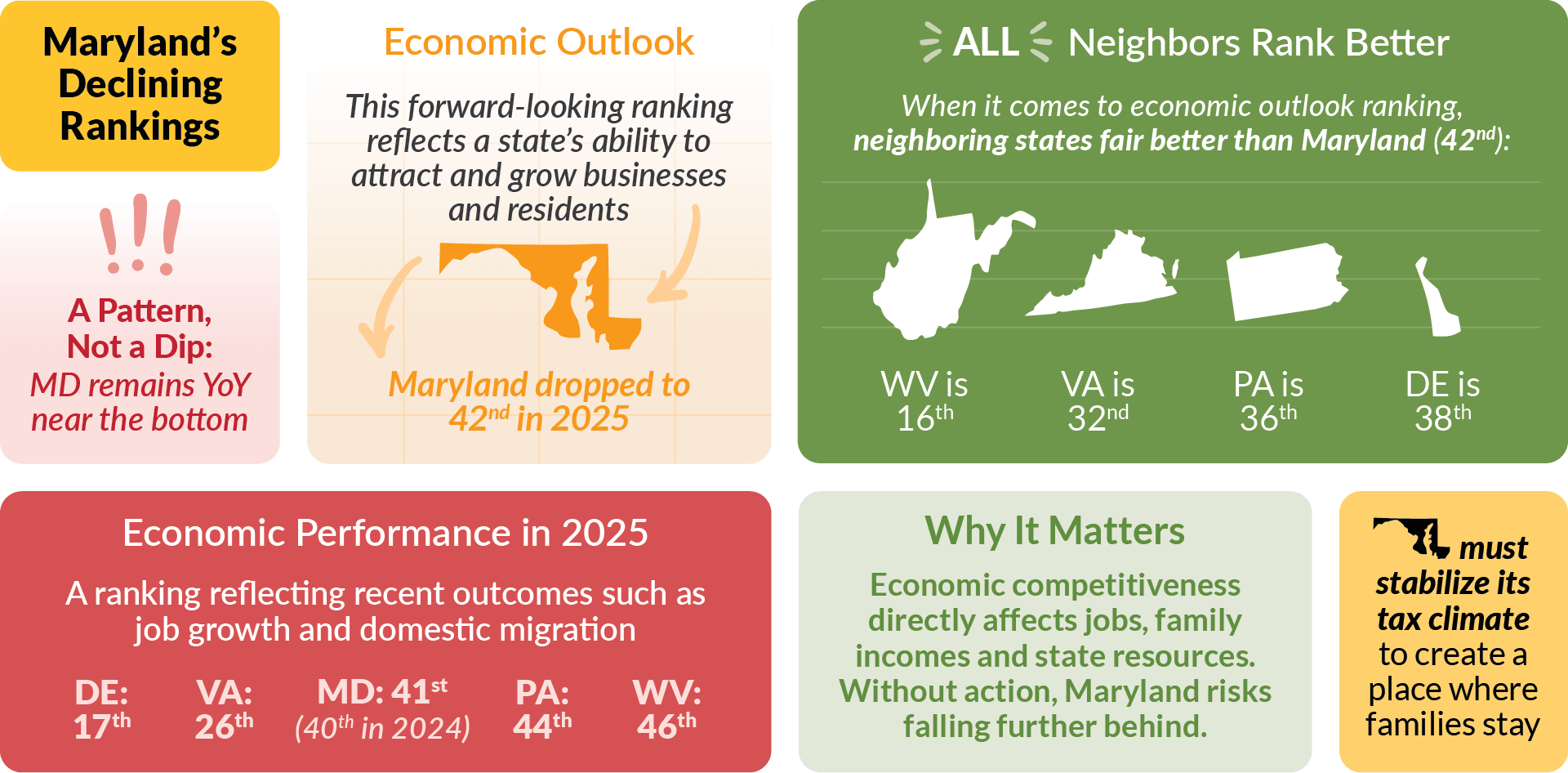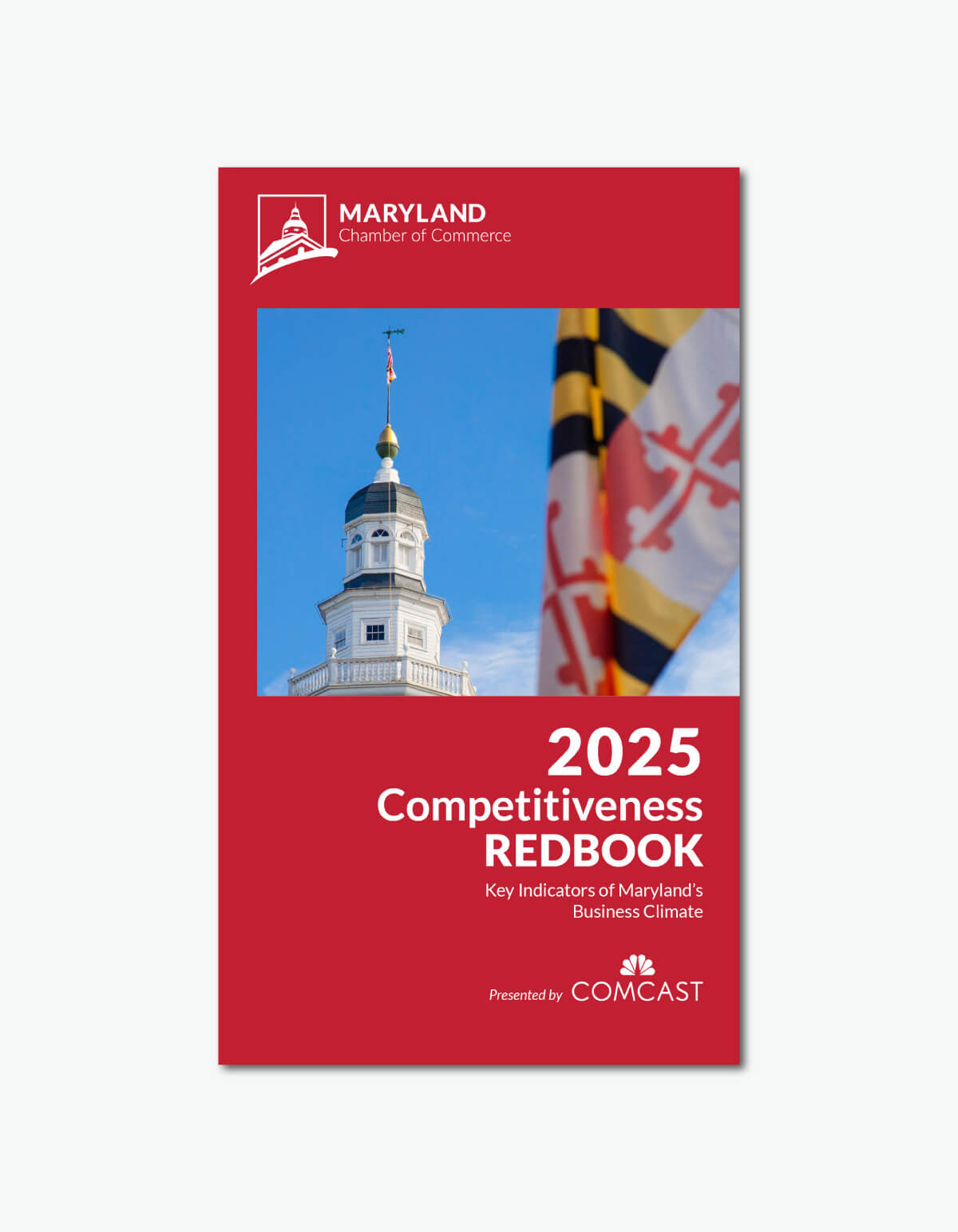Blog
Maryland’s Economic Rankings Are Slipping: Here’s Why That Matters and What We Must Do About It
Oct 30, 2025
Key Takeaways: Maryland’s Declining Economic Rankings
- Maryland’s Rankings Are Low: 42nd in Economic Outlook and 41st in Economic Performance (2025), trailing neighboring states like Virginia (32nd) and Delaware (38th).
- A Pattern, Not a Dip: While other states streamline regulations, cut taxes, and attract investment, Maryland has remained near the bottom.
- Real Consequences: Sluggish job growth, outbound migration and budget shortfalls threaten the state’s long-term economic health.
- Business Climate Matters: Policies that increase costs or create uncertainty discourage investment and growth.

Maryland’s economic competitiveness is slipping — and it’s costing us.
Imagine a small business in Maryland weighing whether to expand or relocate. They’re looking at high costs, unpredictable taxes, and growing regulatory burdens. Meanwhile, competitors in neighboring states are streamlining operations, cutting taxes, and attracting talent. The message is clear: Maryland isn’t the easiest place to grow a business. And the latest national rankings confirm what business owners already feel in their day-to-day operations.
In the latest national rankings, Maryland placed 42nd for economic outlook and 41st for recent performance. These aren’t just numbers — they reflect a reality that affects jobs, families, and the state’s ability to fund essential services. Sluggish job growth, outbound migration, and budget shortfalls show that Maryland is at a pivotal moment. If we want a stronger future, we must prioritize an economy that supports business investment, expansion, and long-term growth.
What Do These Rankings Mean?
- Economic Outlook: A forward-looking ranking based on 15 state policy variables, including tax rates, government size, labor policies and legislative actions. It reflects the state’s ability to attract and grow businesses and residents.
- Economic Performance: A backward-looking ranking reflecting recent outcomes such as job growth, GDP growth and domestic migration.
Why it matters: Economic growth isn’t just good news for businesses — it’s essential for tackling budget deficits, inflation and rising costs of living.
Table 1: Maryland’s Rankings Over Time (Economic Outlook)
| MD '22 | MD '23 | MD '24 | MD '25 | VA '25 | PA '25 | DE '25 | WV '25 | Top-Ranking '25 | |
| Economic Outlook | 42 | 41 | 41 | – 42 | 32 | 36 | 38 | 16 | Utah |
| Economic Performance | 37 | 40 | 40 | – 41 | 26 | 44 | 17 | 46 | Florida |
The latest data from the 2025 Rich States, Poor States rankings by the American Legislative Exchange Council (ALEC) show Maryland consistently near the bottom.
Maryland ranks last among neighboring states in Economic Outlook (42nd), behind Virginia (32nd), Pennsylvania (36th), Delaware (38th), and West Virginia (16th). Economic Performance is near the bottom (41st), while Delaware (17th) and Virginia (26th) are gaining momentum.
This isn’t just a dip — it’s a pattern. While other states improve tax structures, streamline regulations and attract investment, Maryland is falling behind.
A Competitive Business Climate Isn’t a Luxury — It’s a Necessity
To change course, Maryland needs to embrace economic growth as a solution — not a target for new taxes or regulations. Policies like the proposed 3% Tech Tax, expansions of sales tax to business services, or mandates that raise hiring costs send a clear signal: Maryland is closed for business.
A more competitive business environment would create the very economic activity that generates revenue for schools, transportation and public safety — without increasing the burden on employers and workers.
What We’re Advocating For
At the Maryland Chamber of Commerce, we push for a policy environment that attracts growth, rewards innovation, and makes it easier to do business. That means:
- Avoiding policies that raise costs for businesses already facing inflation, workforce shortages, and other economic headwinds.
- Creating a stable, predictable tax climate that encourages long-term planning and investment.
- Streamlining regulations and modernizing permitting to reduce red tape and accelerate growth.
Maryland has the talent, infrastructure, and potential — but we can’t afford to keep losing ground to our neighbors. We need a new course that puts growth first.
Maryland Can Do Better — and It Must
Policymakers have a choice: double down on the status quo, or build an economy that businesses want to grow in — and people want to be part of.
Let’s make Maryland the state where:
- Employers choose to invest
- Workers choose to stay
- Families choose to build their futures
Don’t Sit on the Sidelines: Your Voice Is Needed
Maryland’s economic future depends on the choices we make now. We need to send a clear message: businesses and workers have options, and we want Maryland to be the place they choose.
Here’s how you can help make that happen:
- Join the Maryland Chamber — Stand with 7,000+ businesses who stopped millions in new taxes in 2025. Get connected to lawmakers, receive early warnings on costly legislation, and benefit from proven advocacy that protects your bottom line.
- Contribute to the Maryland Chamber PAC — Fuel the fight against harmful legislation and ensure business voices are heard when it matters most
- Sign Up to be a Maryland Business Advocate — Get alerts when action is needed and contact lawmakers to tell them how proposed policies will impact real businesses and jobs
Sources & Methodology
- Economic Outlook Rankings: Based on ALEC’s Rich States, Poor States (2022–2025 editions), which evaluate 15 policy variables influencing business climate and economic competitiveness.
- Comparative Rankings: State rankings from the same ALEC reports, showing year-over-year changes and comparisons with neighboring states and top performers.
- Tax and Policy Data: Includes marginal tax rates, tax burdens, labor policies, and government spending metrics drawn from state and local government reports analyzed by ALEC.
- Economic Performance Metrics: GDP growth, domestic migration, and employment growth figures underpinning ALEC’s backward-looking economic performance rankings.
- Limitations: Some data reflect policy environments with a lag; rankings are composites and may not capture all regional or sector-specific nuances.
Why It Matters
Economic competitiveness directly affects jobs, family incomes and state resources. Without action, Maryland risks falling further behind, losing businesses and talent to more business-friendly states.
Bottom Line
Maryland must prioritize growth, stabilize its tax and regulatory climate and create an environment where businesses, workers and families choose to stay — or risk being left behind.



